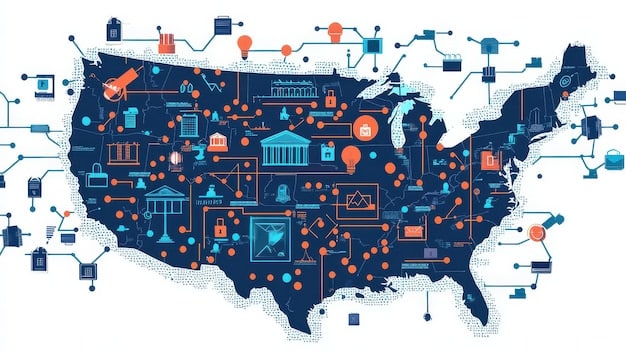5G’s Rural Impact: Opportunities & Challenges in US

The expansion of 5G technology into rural US communities presents a dual landscape of transformative opportunities for economic growth and social connectivity, alongside significant challenges related to infrastructure, cost, and digital equity, necessitating strategic investment and collaborative policy to bridge the digital divide.
The advent of 5G technology has heralded a new era of connectivity, promising unprecedented speeds and capabilities. While urban centers have largely seen the initial rollout, the discussion around The Impact of 5G Expansion on Rural Communities in the US: Opportunities and Challenges is gaining critical momentum. For many in rural America, reliable and high-speed internet remains an elusive dream. Will 5G truly be the technological tide that lifts all boats, or will it exacerbate existing disparities?
The Promise of 5G for Rural America
The potential for 5G to revolutionize rural communities is immense, extending far beyond faster downloads. It promises to unlock new economic opportunities, enhance public services, and drastically improve the quality of life for millions currently left behind in the digital age. This next generation of wireless technology is not just about speed; it is about capacity, low latency, and the ability to connect countless devices simultaneously.
Economic Transformation through Enhanced Connectivity
For rural economies, often reliant on traditional sectors like agriculture and small businesses, 5G offers a pathway to modernization and diversification. Precision agriculture, powered by 5G-connected sensors and IoT devices, can optimize yields, conserve resources, and increase profitability. Farmers could monitor soil conditions, track livestock, and operate automated machinery with unprecedented efficiency, leading to significant cost savings and improved productivity. Beyond agriculture, remote work, e-commerce, and digital entrepreneurship become viable options, fostering local job creation and reducing the need for rural residents to migrate to urban areas for employment. This could revitalize local economies by attracting businesses that depend on robust digital infrastructure.
The ability to conduct high-bandwidth operations from remote locations can also attract new industries to rural areas, provided the necessary infrastructure is in place. Data centers, logistics hubs, and advanced manufacturing facilities, which increasingly rely on real-time data processing and automation, could find cost-effective locations with accessible 5G networks. This geographic flexibility, enabled by advanced connectivity, could lead to a more distributed national economy.
Revolutionizing Public Services and Quality of Life
5G’s impact on public services in rural areas could be transformative. Telemedicine, for example, would allow rural patients to consult with specialists in urban centers, reducing travel burdens and improving access to critical healthcare services. Emergency responders could leverage 5G for real-time data transfer, enhancing their ability to coordinate and respond effectively to incidents.
- Education: Enhanced broadband access through 5G can facilitate online learning, providing rural students with equal access to educational resources and virtual classrooms, bridging academic gaps.
- Public Safety: Real-time data sharing among emergency services could improve response times and situational awareness, making rural areas safer.
- Smart Utilities: 5G enables smart grids for electricity and water, leading to more efficient resource management and reduced waste.
- Community Engagement: Faster and more reliable internet fosters greater civic participation and access to government services online.
Furthermore, 5G can contribute to the development of smart rural communities, where connected sensors monitor environmental conditions, manage traffic, and optimize energy consumption. This leads to more sustainable and livable environments, attracting new residents and businesses. The overall quality of life would see a significant upgrade, as connectivity becomes a seamless part of daily existence, akin to essential utilities.
In essence, beyond mere technological advancement, 5G in rural America presents a profound opportunity for societal equity. It can level the playing field, ensuring that geographic location does not dictate access to economic prosperity, quality education, or essential healthcare. The full realization of these opportunities, however, hinges on overcoming substantial challenges.
Challenges in 5G Deployment: Navigating the Rural Terrain
Despite the compelling promise, the path to widespread 5G deployment in rural communities is fraught with considerable challenges. These obstacles range from the immense financial investment required to the unique geographical complexities and policy hurdles that often impede progress. Addressing these issues is paramount to ensure that 5G benefits are equitably distributed across the US.

Infrastructure Costs and Economic Viability
The primary hurdle for 5G expansion in rural areas is the sheer cost of building out the necessary infrastructure. Unlike 4G, which largely relied on existing cell towers, 5G employs a denser network of smaller cell sites, particularly for its high-band millimeter-wave (mmWave) frequencies that deliver ultra-fast speeds but have limited range. This necessitates a significant investment in new towers, fiber-optic backbone, and countless small cells.
Rural areas, characterized by sparse populations and vast distances, present a less attractive business case for private telecommunication companies. The lower population density means fewer subscribers per cell site, making it difficult to recoup initial investment costs and maintain profitability. This “last mile” problem, where the cost of connecting the final isolated homes and businesses far outweighs the potential revenue, is a persistent barrier. Without robust government incentives or public-private partnerships, many rural communities may remain underserved or entirely unserved by advanced 5G networks.
Geographical Obstacles and Technical Complexities
The varied and often rugged terrain of rural America poses unique technical challenges for 5G deployment. Mountains, dense forests, and vast agricultural lands can obstruct wireless signals, especially the higher frequencies of 5G which are more susceptible to interference and have shorter propagation distances. Deploying fiber optic cables, essential for backhauling data from 5G cell sites, through such landscapes can be incredibly expensive and time-consuming, requiring extensive environmental assessments and specialized construction.
Moreover, the energy demands of a denser 5G network are higher, posing logistical challenges for power supply in remote locations. Ensuring reliable power sources and backup systems for numerous small cells scattered across wide areas adds another layer of complexity and cost. These technical and geographical impediments often require innovative solutions and substantial investment in engineering and deployment strategies.
Regulatory Hurdles and Policy Imperatives
Navigating the regulatory landscape for 5G deployment can be cumbersome and slow, particularly at local, state, and federal levels. Permitting processes for tower construction, rights-of-way for fiber installation, and environmental reviews can be protracted, delaying crucial projects. Disparate regulations across different jurisdictions further complicate the rollout, creating a patchwork of requirements rather than a streamlined national approach.
- Streamlined Permitting: Local governments need to simplify and accelerate permit approvals for 5G infrastructure.
- Consistent Regulations: Federal and state agencies should work towards more uniform guidelines to avoid regulatory fragmentation.
- Spectrum Availability: Ensuring sufficient and affordable spectrum is allocated for rural 5G deployment is critical.
- Digital Equity Initiatives: Policies must specifically address the digital divide to ensure equitable access.
Policies must not only encourage infrastructure build-out but also address digital equity by ensuring affordability and accessibility for all residents. Without targeted subsidies or programs to assist low-income rural households, even if 5G infrastructure becomes available, it may remain out of reach. The successful integration of 5G into rural communities thus requires a coordinated, multi-faceted approach, combining financial incentives, technological innovation, and clear, supportive regulatory frameworks.
Leveraging 5G for Smart Agriculture and Rural Industry
The integration of 5G technology holds transformative power for rural economies, particularly in modernizing traditional sectors like agriculture and fostering new industrial growth. Beyond simple connectivity, 5G enables a suite of advanced applications that can significantly boost efficiency, productivity, and sustainability in rural areas.
Precision Agriculture: A New Era of Farming
Precision agriculture, already gaining traction, is poised for a massive leap forward with the advent of 5G. This technology provides the low latency and high bandwidth necessary for real-time data collection and analysis, enabling farmers to make highly informed decisions. Imagine fields dotted with sensors that continuously monitor soil moisture, nutrient levels, and crop health, transmitting this data instantly to a central system via 5G. Farmers can then apply water, fertilizer, or pesticides only where and when needed, minimizing waste and maximizing yields.
Automated machinery, such as self-driving tractors and drones, will communicate seamlessly over 5G networks, allowing for precise planting, spraying, and harvesting operations. This level of automation can address labor shortages in agriculture and optimize resource use, leading to increased profitability and environmental benefits. Livestock management can also be revolutionized, with wearable sensors tracking animal health and location in real-time, preventing disease outbreaks and optimizing grazing patterns.
The ability to connect numerous IoT devices across vast fields without performance degradation is a game-changer. It means less time spent manually monitoring and more time dedicated to strategic decision-making, transforming farming from a labor-intensive venture into a high-tech operation. This shift also broadens the skill sets required in rural communities, fostering new educational and employment opportunities in agricultural technology.
Enabling Rural Manufacturing and Connected Industry
Beyond agriculture, 5G offers significant potential for rural industrial revitalization. The technology can support smart manufacturing initiatives, where factories are equipped with interconnected machines, sensors, and robots that communicate in real-time. This enables predictive maintenance, optimized production lines, and enhanced quality control, all of which are crucial for competitive manufacturing.
- Real-time Data Exchange: Facilitates instant communication between machines, sensors, and control systems, crucial for efficiency.
- Automated Logistics: Improves supply chain management with connected vehicles and inventory tracking.
- Remote Monitoring: Allows for off-site supervision and control of industrial processes, reducing the need for on-site personnel.
- Augmented Reality for Maintenance: Enables technicians to use AR for remote diagnostics and repair instructions, minimizing downtime.
For rural areas seeking to attract new businesses, the promise of 5G-enabled industrial capabilities can be a strong draw. Companies needing reliable and fast connectivity for their advanced operations might find rural locations more appealing, offering lower overheads and available land. This could lead to a diversification of rural economies, moving beyond traditional sectors and creating new, high-skill jobs.
Furthermore, 5G can facilitate the decentralization of some manufacturing processes, allowing companies to establish smaller, more agile production units closer to raw materials or customer bases. This distributed model, supported by robust 5G connectivity, could reduce transportation costs and environmental impact, while fostering local specialization and innovation in rural industrial parks.
Addressing the Digital Divide: Equity and Access to 5G
The expansion of 5G into rural areas, while promising, necessitates a focused effort to ensure it doesn’t exacerbate the existing digital divide. True equity in access means more than just infrastructure; it involves addressing affordability, digital literacy, and the availability of essential services delivered over these networks.
Ensuring Affordability for Rural Households
Even if 5G infrastructure is built, cost remains a significant barrier for many rural households. High subscription fees for 5G services, combined with the cost of 5G-compatible devices, can place this advanced technology out of reach for a substantial portion of the population, particularly in low-income communities. Without targeted subsidies or affordable service plans, the digital divide will persist, merely shifting from a lack of infrastructure to a lack of affordability.
Government programs, like the Affordable Connectivity Program (ACP), are crucial in bridging this gap by providing subsidies to low-income families for internet service. However, such programs need to be adequately funded and widely publicized to be effective. Telecommunication companies could also be incentivized to offer tiered pricing structures or specific rural packages that make 5G more accessible. Public-private partnerships could explore community-owned networks or cooperative models that prioritize affordability over profit margins, ensuring that no one is left behind purely due to financial constraints.
Promoting Digital Literacy and Skills Training
Access to 5G technology is only beneficial if people know how to use it effectively. Many rural residents, particularly older populations or those in economically disadvantaged areas, may lack the digital literacy skills necessary to leverage the full potential of advanced connectivity. This includes basic computer skills, understanding online safety, and knowledge of how to access essential services like telemedicine or online education.
- Community Training: Local libraries, community centers, and non-profits can offer free digital literacy courses.
- Online Resources: Development of accessible online tutorials and guides tailored to various skill levels.
- School Programs: Integrating digital skills training into standard curricula from early education.
- Workforce Development: Partnering with local businesses and colleges to offer specialized training for 5G-enabled industries.
Investing in digital literacy programs and skills training is as important as investing in infrastructure. These initiatives can be delivered through local libraries, community centers, or partnerships with educational institutions. By empowering rural residents with the knowledge and confidence to navigate the digital world, the true societal benefits of 5G can be realized, fostering greater economic participation and access to information.
Addressing the digital divide requires a holistic approach that goes beyond simply laying fiber and erecting towers. It demands thoughtful policy, sustainable financial models, and comprehensive educational initiatives that prepare rural communities not just for connectivity, but for meaningful participation in the digital economy and society. The goal should not just be to close the gap, but to create equitable opportunities.
Policy and Investment: Driving Rural 5G Adoption
The successful expansion of 5G into rural America hinges significantly on strategic policy frameworks and substantial public and private investment. Without coordinated efforts from government agencies, telecommunication companies, and local communities, the benefits of 5G risk remaining concentrated in urban centers, widening the existing digital chasm.
Governmental Incentives and Funding Mechanisms
Federal and state governments play a crucial role in de-risking rural 5G deployment for private companies through various incentives and funding programs. Subsidies, grants, and tax credits can help offset the high initial capital expenditure associated with building infrastructure in sparsely populated areas. Programs like the Universal Service Fund (USF) and initiatives from the Department of Commerce’s National Telecommunications and Information Administration (NTIA) are vital for directing resources towards underserved regions.
Moreover, direct public funding for broadband infrastructure projects can ensure that critical areas are connected, even if they are not immediately profitable for private providers. This might involve funding for “middle mile” fiber optic networks that connect rural communities to the broader internet backbone, making subsequent “last mile” connections more feasible. Governments can also create low-interest loan programs or loan guarantees to incentivize investment in rural broadband infrastructure, making these projects more attractive to investors.
Crucially, these funding mechanisms must be accompanied by clear, consistent guidelines and efficient application processes to ensure that funds are dispersed effectively and quickly. The goal is to stimulate build-out while ensuring accountability and transparency in how taxpayer money is spent, directly addressing the core market failures that lead to rural underinvestment.
Public-Private Partnerships and Local Engagement
Collaborative models, where the public and private sectors work hand-in-hand, are often the most effective way to address complex infrastructure challenges like rural 5G expansion. These partnerships can leverage the financial resources of government with the technical expertise and operational efficiency of private telecommunication companies. This can take various forms, such as shared infrastructure agreements, where companies co-locate equipment on existing towers or share the costs of new fiber deployment.
- Shared Infrastructure: Encourages multiple providers to use the same physical infrastructure, reducing costs.
- Community Broadband: Supports local initiatives for building and owning their networks, often with public funding.
- Innovative Funding Models: Explores bond issues or special assessment districts to finance infrastructure.
- Strategic Planning: Develops long-term plans with input from all stakeholders to ensure sustainable growth.
Local community engagement is also paramount. Rural communities themselves often possess a deep understanding of their unique needs and challenges. They can play a pivotal role in identifying optimal locations for infrastructure, streamlining local permitting processes, and helping to identify local workforce development opportunities for jobs created by 5G deployment. Empowering local leaders to participate actively in the planning and implementation phases fosters a sense of ownership and ensures that solutions are tailored to specific community contexts. This localized approach, combined with broader policy efforts, creates a robust framework for expanding 5G access equitably and efficiently.
Ultimately, sustained political will to prioritize rural connectivity, backed by significant and strategic investment, is essential. The economic and social returns on such investments are substantial, justifying the considerable outlay required to bring 5G to all corners of the nation.
Case Studies and Future Outlook for Rural 5G Adoption
Examining early adoption examples and projecting future trends provides valuable insights into the opportunities and challenges of rural 5G expansion. While still in its nascent stages in many areas, the lessons learned from pilot programs and the ongoing trajectory of technology suggest a complex but potentially transformational future.
Spotlight on Early Adoption and Pilot Programs
Several rural communities across the US have begun implementing 5G pilot programs, offering glimpses into its real-world impact. For instance, parts of rural Oklahoma have seen 5G deployments focused on connecting agricultural operations, enabling real-time monitoring of crop conditions and automated irrigation systems. These early successes demonstrate the tangible economic benefits, such as increased yields and reduced resource consumption, that 5G can bring to farming. In certain remote healthcare facilities, 5G has facilitated high-definition telehealth consultations and remote diagnostics, improving access to specialized medical care for patients hundreds of miles from urban hospitals.
These pilot programs often highlight the need for customized solutions due to varying geographical and economic conditions. Some have found success with fixed wireless access (FWA) as a cost-effective alternative to fiber for the “last mile,” especially where terrain is challenging. Others have prioritized sub-6 GHz 5G frequencies, which offer better range and penetration than mmWave, making them more suitable for covering vast rural expanses at slightly lower speeds. The diversity in these early efforts underscores that there is no one-size-fits-all solution for rural 5G deployment.
Each case study serves as a learning opportunity, revealing best practices in terms of funding models, community engagement, and technical deployment strategies. They also expose critical gaps, such as the persistent need for better digital literacy programs and consistent regulatory frameworks that accelerate, rather than impede, progress.
Projected Trends and Long-Term Implications
Looking ahead, several trends are likely to shape the future of 5G in rural America. Continued federal and state funding initiatives are expected, likely focusing on targeted subsidies for infrastructure build-out and programs to ensure affordability for end-users. The development of more cost-effective 5G deployment technologies, such as advanced software-defined networks and more efficient antenna designs, will also play a crucial role in making rural deployments more economically viable.
- Increased Fixed Wireless Access (FWA): Likely to be the dominant 5G solution for rural broadband due to its cost-effectiveness over fiber to the home.
- Edge Computing Growth: More data processing will occur locally in rural areas, fostering new local industries and reducing reliance on distant data centers.
- IoT Proliferation: Expansion of connected devices in agriculture, smart cities, and industries, generating vast amounts of data.
- Sustainable Development: 5G increasingly linked to smart energy grids and environmental monitoring for rural sustainability.
The long-term implications are profound. A fully connected rural America could experience a renaissance, attracting younger generations and new businesses, revitalizing local economies, and fostering innovation. The digital divide, if successfully bridged, would transform from a barrier to opportunity, allowing rural communities to fully participate in the global digital economy. However, challenges like cybersecurity risks for interconnected devices and the need for ongoing maintenance and upgrades will remain. The future of rural 5G adoption is not just about technology; it’s about building resilient, connected, and prosperous communities for decades to come, requiring continuous adaptation and strategic investment.
The trajectory points towards a more interconnected and technologically advanced rural landscape, but the pace and equity of this transformation will depend heavily on sustained policy commitment and collaborative efforts from all stakeholders.
| Key Aspect | Brief Description |
|---|---|
| 🚀 Opportunities | 5G promises economic growth, enhanced public services like telemedicine, and precision agriculture. |
| 🚧 Challenges | High infrastructure costs, geographical hurdles, and complex regulations impede widespread rollout. |
| 🤝 Policy & Investment | Government incentives, public-private partnerships, and local engagement are crucial for success. |
| 💡 Digital Equity | Ensuring affordability and digital literacy is essential to bridge the digital divide for all rural residents. |
Frequently Asked Questions About Rural 5G
5G can drive significant economic growth in rural areas by enabling precision agriculture, attracting remote workforces, and fostering digital entrepreneurship. Its high speeds and low latency support advanced technologies like IoT sensors for farming efficiency and connected devices for small businesses, leading to increased productivity and new job creation.
Rural 5G deployment faces unique challenges, including vast geographical distances, rugged terrain obstructing signals, and lower population densities that make infrastructure investments less profitable for private companies. The high costs of building extensive new networks and addressing logistical complexities in remote locations are significant deterrents.
Governments can bridge the divide through financial incentives such as subsidies, grants, and tax credits for infrastructure build-out. They can also fund public-private partnerships, streamline regulatory processes, and implement programs to ensure affordability of 5G services for low-income households, fostering equitable access and adoption across rural communities.
Precision agriculture will be revolutionized by 5G, allowing for real-time data collection from sensors and automated machinery. This enables farmers to precisely monitor soil, crops, and livestock, optimizing resource use, increasing yields, and reducing waste. 5G’s low latency and high capacity are essential for seamless operation of these advanced farming systems.
Beyond basic internet access, 5G can transform rural healthcare via telemedicine, enhance education through remote learning capabilities, and improve public safety with real-time data for emergency responders. It also facilitates smart community initiatives like intelligent utilities and environmental monitoring, significantly improving the overall quality of life.

Conclusion
The expansion of 5G into rural communities across the US represents a pivotal moment in the nation’s technological and social development. While presenting an array of unprecedented opportunities for economic revitalization, enhanced public services, and significant improvements in quality of life, it is clear that its effective and equitable deployment is not without formidable challenges. From the substantial infrastructure costs and complex geographical considerations to the ongoing need for robust policy frameworks and digital literacy initiatives, the path forward requires a multi-faceted and collaborative approach. By strategically addressing these hurdles through targeted investment, innovative public-private partnerships, and a sustained commitment to digital equity, 5G has the potential to truly bridge the long-standing digital divide, fostering resilient, prosperous, and connected rural communities for generations to come. The effort to empower all Americans with this transformative technology is not merely an infrastructure project, but a commitment to a more inclusive and equitable future.





